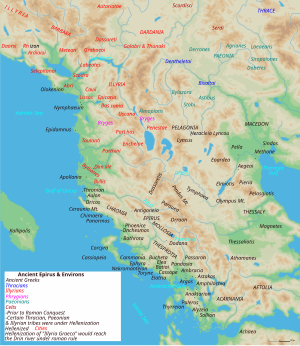Chaonia
| Chaonia (Χαονία) | |
|---|---|
| Region of Ancient Greece | |
 Theatre of Buthrotum | |
| Location | Northern/Northwestern Epirus |
| Tribal state (later subdivision of Epirus) | 8th–2nd centuries BC |
| Language | Northwestern Greek |
| Capital | Phoenice |
 | |
Chaonia or Chaon (Greek Χαονία or Χάων) was the name of the northwestern part of Epirus, the homeland of the Epirote Greek tribe of the Chaonians.[1][2] Its main town was called Phoenice. According to Virgil, Chaon was the eponymous ancestor of the Chaonians.[3]
Geography[]
Strabo in his Geography,[4] places Chaonia between the Ceraunian mountains in the north and the River Thyamis in the south. The Roman historian, Appian, mentions Chaonia as the southern border in his description and geography of Illyria.[5]
Important cities in Chaonia included Cestrine (modern Filiates), Chimaera (modern Himarë), Buthrotum, Phoenice, Cassiope (Modern Kassiopi) Panormos, Ilium (modern Despotiko) Onchesmus (modern Sarandë) and Antigonia.
Mythology[]
In Vigil's Aeneid, Aeneas visits Chaonia and meets Andromache and Helenus. He is told he must continue on to Italy, and instructed to meet the Sibyl concerning a more specific prophecy as to Aeneas's destiny.[6]
See also[]
References[]
- ^ Errington, Malcolm. A History of Macedonia. University of California Press, 1990.
- ^ The Cambridge Ancient History: Vol. 6, the Fourth Century BC.
- ^ Virgil. Aeneid, 3.295.
- ^ Strabo. The Geography. Book VII, Chapter 7.5 (LacusCurtis).
- ^ Appian. The Foreign Wars, III.1 (ed. Horace White).
- ^ Virgil (1993). Aeneid. Translated by Fitzgerald, Robert. New York: Alfred A. Knopf. ISBN 0-679-41335-9.
External links[]
- Chaonia
